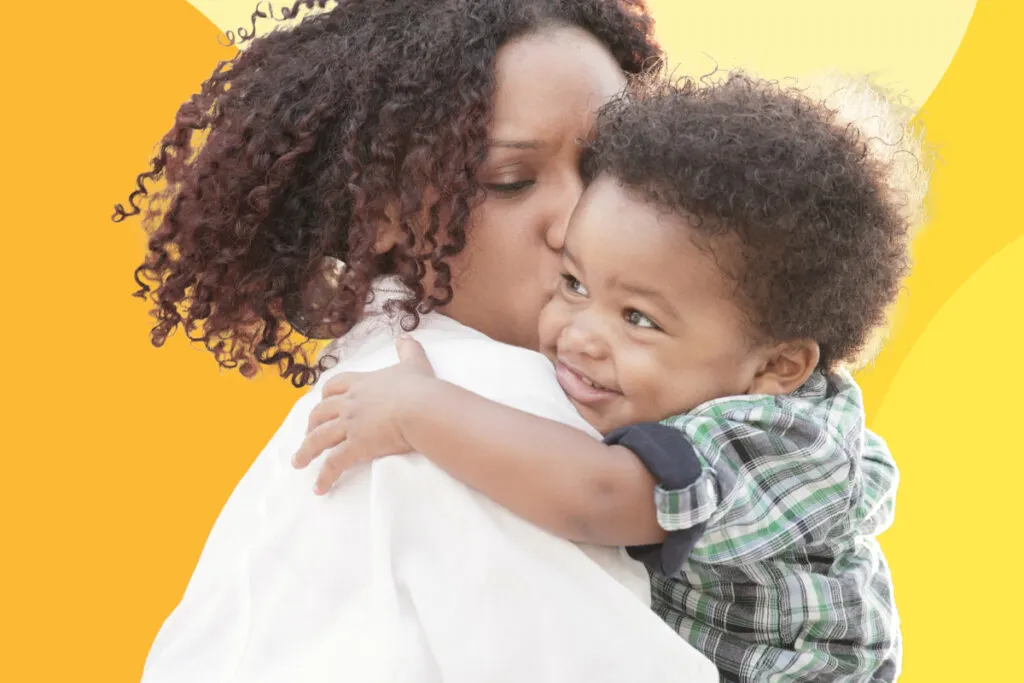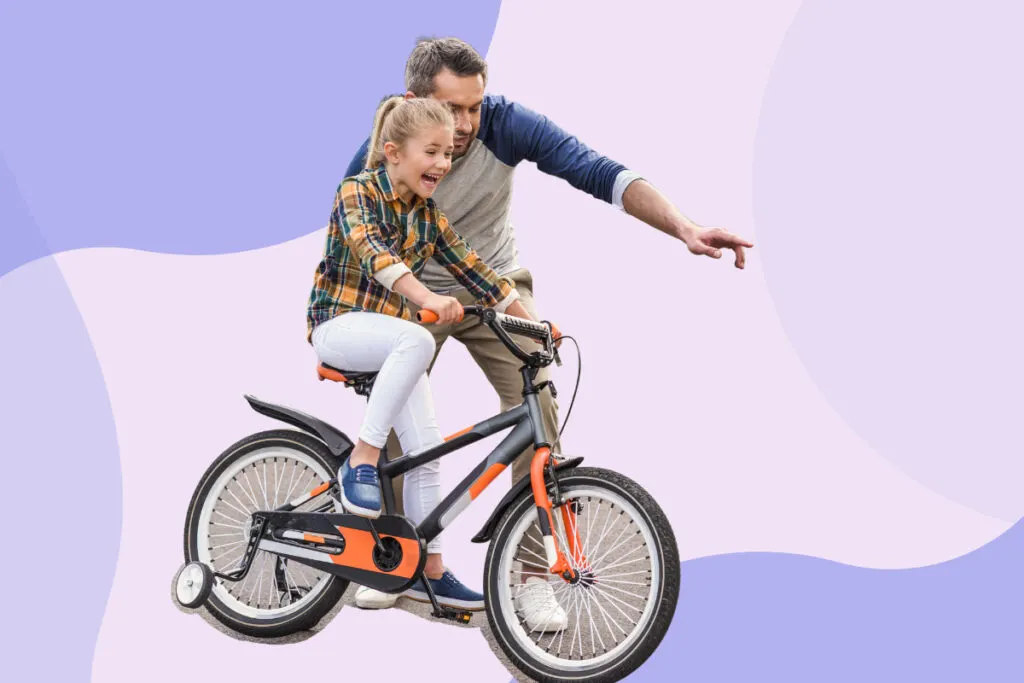TABLE OF CONTENTS
What is co-regulation
Coregulation is an interpersonal process in which participants continuously adjust their interactions in a coordinated pattern to co-create and maintain a positive emotional state 1.
During emotion co-regulation, participating partners co-regulate by adapting their actions to regulate one another in a cooperative way 2. This mutual regulation between people involves matching, mismatching, rupturing, and repairing connections 3.
An individual learns to self-regulate by first co-regulating with others 4.

Why is co-regulation important
Co-regulation is important because it is a way for parents to help their children develop emotional self-regulation.
Emotional regulation is essential for healthy child development. Studies have found strong links between social-emotional development and a child’s successful functioning in a lot of areas, from physical and mental health to academic performance and socioeconomic success.
Difficulties in self-regulation development are associated with many negative outcomes in adolescence and adulthood.

How Emotional Regulation Develops In The Brain
Emotional regulation begins with co-regulation with the primary caregiver.
Infants have limited abilities to regulate themselves at the beginning of life.
When babies are upset, they depend heavily on their primary caregivers to cope and restore their emotional balance. They learn how to communicate and manage their feelings based on the caregiver’s responses to their negative emotions5.
The experiences of receiving external support serve as scaffolds for children to develop their own ability to deal with emotional distress.
Coregulation with parents is like teaching children how to ride a bike.
In the beginning, the young child simply sits there while the parent does all the work holding up the bike and pushing it forward. But soon, the child gets used to balancing on the bike. They start pedaling and balancing on their own. At some point, the parent can let go.
Holding up the bike at the beginning is essential for the child to learn to bike.
Without the parent, the child will likely fall and get hurt. When it becomes too much, they may give up.
Similarly, without coregulation, a child may experience dysregulation, such as outbursts or aggression, and develop a maladaptive coping strategy, such as emotion suppression, that results in internalizing issues.
Coregulation is, therefore, essential in helping a child create calming connections in their brain. Your calming energy is translated to your child’s calmness.
Also See: Still Face Experiment – Why Parenting Matters for Child Development
Before the emotional co-regulation process begins
Here are the important steps before parents co-regulate with their children.
First, self-regulate
Parents’ self-regulation is an important part of co-regulation. Adults are role models for their children on how to control their emotions.
It can be challenging to deal with a screaming, irrational child during acute tantrum episodes, especially if the situation has already triggered big feelings in you.
Calm your nervous system by taking deep breaths, clearing your mind, and using positive self-talk.
Your past experience, thoughts, and beliefs about emotions will affect how well you manage your emotions.
Be mindful of your own state of mind and stay in the presence.
If it becomes too difficult for you to control your emotions when your child is upset, seek professional help. In therapy, mental health professionals can assist you in identifying and addressing unresolved issues that could prevent you from being a calm, caring parent.
Do not punish
A baby cannot help what they feel.
Punishing the expression of negative emotions is especially harmful as it can aggravate them in difficult moments.
Punishment also prevents a child from receiving co-regulation from the caregiver6.
Do not invalidate emotions
Do not ignore, dismiss, or reject negative emotions.
A child’s feelings of invalidation are associated with social-emotional difficulties and psychological distress7.
Responsive parenting
Warm, supportive, and responsive interaction can foster a close connection and secure attachment in children8.
Responsive parents recognize and respond to children’s cues that signal their needs. Caring interactions help children to understand, express, and manage emotions.
A securely attached child internalizes regulation strategies within their attachment relationship and applies them in other relationships or connections9.
Be patient and consistent
It is important to be patient and nonjudgmental during the engagement. The effect of coregulation does not appear overnight. Your child benefits from your patience and consistency.
How to co-regulate
Throughout development, co-regulated experiences are a critical resource for children, but the types of co-regulating behaviors can change as the kids’ self-regulating capacity grows.
Changes in the parent’s response can scaffold the child’s emotional experiences, guiding them to use increasingly sophisticated ways to self-regulate10.
Each person develops their social-emotional skills at a different rate. Here is a general guideline on co-regulating at different stages. Your family may vary and require a bit of modification using the same principles.
Infancy (birth to age 1)
Pay attention closely and respond quickly to the cues your child sends. Comfort them physically with caring gestures (e.g., holding and hugging) and emotionally (e.g., speaking in a soft voice) to help them stabilize.
Reductions in distress can also be achieved by modifying the environment. For example, move them to another room or space with less stimulation.
Toddlerhood (ages 1 to 2)
Hug them and speak in a calm tone of voice.
Distract them or shift their focus to something else.
Remove your child from the stressful place and create a sense of safety.
Teach them words to express their emotions.
Preschool-aged (ages 3 to 5)
Using soothing touches and words to calm your child’s body.
Model and teach your child self-regulating tools such as mindful breathing. Take a long deep breath while counting to 3, and breathe out slowly. Repeat a few times until they are calm.
Emotion-coach them to learn about their feelings, label their emotions, and express them with words.
Help them identify sensations that signal dysregulation so they can use the techniques before the level of anxiety escalates. Encourage them to practice.
Teach simple problem-solving skills by suggesting options.
Middle childhood (ages 6 to 10)
Encourage your child to use more problem-solving strategies and take action.
Continue to coach them on emotion management skills, such as reappraising the situation or listening to music.
Early adolescence (ages 11 to 14)
Teach your child problem-solving, organization, and time-management skills in order to prevent problems.
Coach them on healthy stress management, such as exercising and meditating.
Teach them critical thinking so they can make better decisions. Ask them questions. You can tell a story or encourage them to see things from someone else’s perspective.
From late adolescence to adulthood
At this time, co-regulatory interactions give way to the child’s emerging self-regulation skills. Your child is taking on most of the regulating tasks.
You now primarily provide guidance for complex problems and emotional support in dealing with significant stressors. You serve as the child’s secure base and safe haven while they handle the rest.
References
- 1.Feldman R. Infant-mother and infant-father synchrony: The coregulation of positive arousal. Infant Ment Health J. Published online January 2003:1-23. doi:10.1002/imhj.10041
- 2.Fogel A, Garvey A. Alive communication. Infant Behavior and Development. Published online May 2007:251-257. doi:10.1016/j.infbeh.2007.02.007
- 3.Tronick EZ. Emotions and emotional communication in infants. American Psychologist. Published online 1989:112-119. doi:10.1037/0003-066x.44.2.112
- 4.Herbers JE, Cutuli JJ, Supkoff LM, Narayan AJ, Masten AS. Parenting and coregulation: Adaptive systems for competence in children experiencing homelessness. American Journal of Orthopsychiatry. Published online July 2014:420-430. doi:10.1037/h0099843
- 5.Perry NB, Dollar JM, Calkins SD, Keane SP, Shanahan L. Maternal socialization of child emotion and adolescent adjustment: Indirect effects through emotion regulation. Developmental Psychology. Published online March 2020:541-552. doi:10.1037/dev0000815
- 6.Eisenberg N, Cumberland A, Spinrad TL. Parental Socialization of Emotion. Psychological Inquiry. Published online October 1998:241-273. doi:10.1207/s15327965pli0904_1
- 7.Krause ED, Mendelson T, Lynch TR. Childhood emotional invalidation and adult psychological distress: the mediating role of emotional inhibition. Child Abuse & Neglect. Published online February 2003:199-213. doi:10.1016/s0145-2134(02)00536-7
- 8.Mikulincer M, Shaver PR. Attachment orientations and emotion regulation. Current Opinion in Psychology. Published online February 2019:6-10. doi:10.1016/j.copsyc.2018.02.006
- 9.Brumariu LE. Parent-Child Attachment and Emotion Regulation. New Directions for Child and Adolescent Development. Published online June 2015:31-45. doi:10.1002/cad.20098
- 10.Crugnola CR, Gazzotti S, Spinelli M, Ierardi E, Caprin C, Albizzati A. Maternal attachment influences mother–infant styles of regulation and play with objects at nine months. Attachment & Human Development. Published online March 2013:107-131. doi:10.1080/14616734.2013.745712
